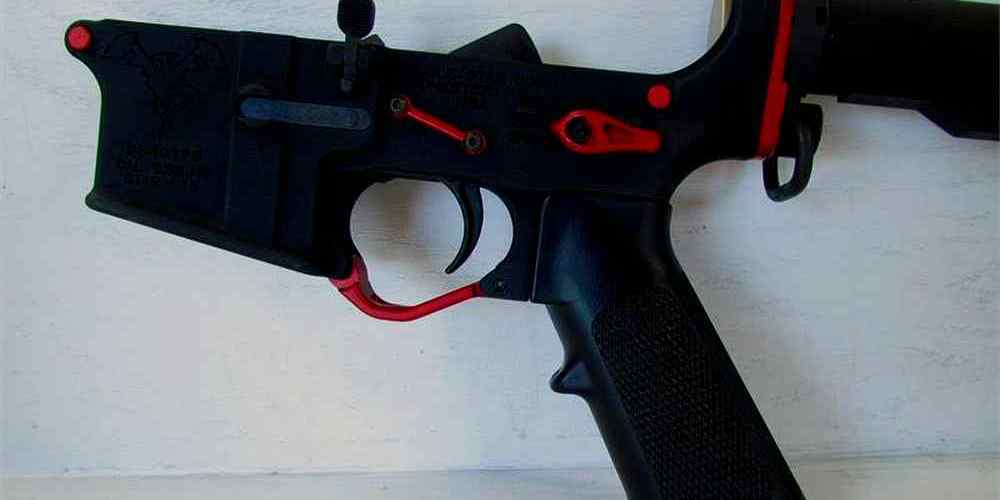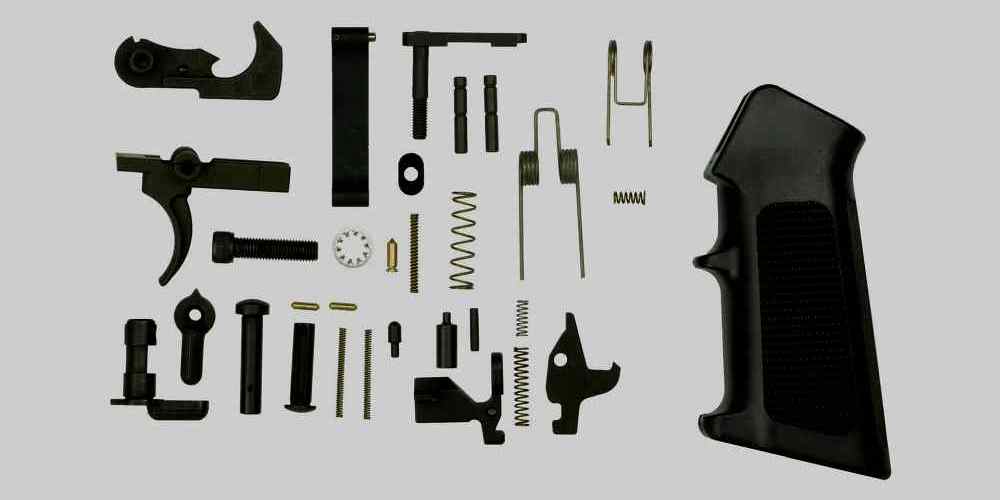“Balancing cost and quality for the perfect AR15 lower receiver.”
Comparing Materials: Aluminum vs. Polymer Lower Receivers
When it comes to building or customizing an AR15 rifle, one of the most important decisions you’ll have to make is choosing the right lower receiver. The lower receiver is essentially the backbone of your rifle, housing the trigger group, magazine well, and buffer tube. It’s crucial to find a lower receiver that strikes the right balance between cost and quality, as this component plays a significant role in the overall performance and reliability of your firearm.
One of the first decisions you’ll need to make when selecting a lower receiver is choosing between aluminum and polymer materials. Both materials have their own set of advantages and disadvantages, so it’s important to weigh these factors carefully before making a decision.
Aluminum lower receivers are the traditional choice for AR15 builds, and for good reason. Aluminum is a durable and lightweight material that offers excellent strength and rigidity. This makes aluminum lower receivers highly resistant to wear and tear, ensuring that your rifle will perform reliably over time. Additionally, aluminum is a popular choice for those who prioritize aesthetics, as it can be easily customized with various finishes and coatings.
On the other hand, polymer lower receivers have gained popularity in recent years due to their affordability and lightweight construction. Polymer is a synthetic material that is resistant to corrosion and rust, making it an attractive option for those who live in humid or wet environments. Additionally, polymer lower receivers are often more comfortable to hold and shoot, as they tend to absorb recoil better than aluminum counterparts.
While polymer lower receivers offer some distinct advantages, they do come with a few drawbacks. Polymer is generally less durable than aluminum, meaning that polymer lower receivers may not hold up as well under heavy use or abuse. Additionally, polymer lower receivers may not be as compatible with certain aftermarket parts or accessories, as they may not have the same level of precision machining as aluminum receivers.
Ultimately, the decision between aluminum and polymer lower receivers will come down to your personal preferences and priorities. If you prioritize durability and customization options, an aluminum lower receiver may be the best choice for you. On the other hand, if you’re looking for a lightweight and affordable option that offers good recoil absorption, a polymer lower receiver may be more suitable.
Regardless of which material you choose, it’s important to do your research and choose a reputable manufacturer when selecting a lower receiver. Look for companies that have a track record of producing high-quality products and have a good reputation within the firearms community. By investing in a well-made lower receiver, you can ensure that your AR15 build will be reliable and perform well for years to come.
Understanding Manufacturing Processes: Forged vs. Billet Lower Receivers
When it comes to building or customizing an AR15 rifle, one of the most important decisions you’ll have to make is choosing the right lower receiver. The lower receiver is essentially the backbone of your rifle, housing the trigger group, magazine well, and buffer tube. It’s crucial to select a high-quality lower receiver that will provide durability, reliability, and performance. However, with so many options on the market, it can be overwhelming to determine which lower receiver is the best value for your money.

One of the key factors to consider when choosing a lower receiver is the manufacturing process. Lower receivers are typically made using one of two methods: forging or billet machining. Each method has its own set of advantages and disadvantages, so it’s important to understand the differences between the two before making a decision.
Forged lower receivers are made by hammering a solid piece of aluminum into shape using a die. This process creates a strong and durable lower receiver that is resistant to wear and tear. Forged lower receivers are also typically more affordable than billet machined receivers, making them a popular choice among budget-conscious shooters.
On the other hand, billet machined lower receivers are made by cutting a solid block of aluminum into shape using a CNC machine. This process allows for more intricate designs and customization options, making billet receivers a popular choice among those looking for a unique and personalized rifle build. However, billet receivers are typically more expensive than forged receivers due to the additional machining process involved.
When it comes to choosing between forged and billet lower receivers, it ultimately comes down to your personal preferences and budget. If you’re looking for a reliable and affordable option, a forged lower receiver may be the best choice for you. However, if you’re willing to invest a bit more money for a higher level of customization and aesthetics, a billet machined lower receiver may be the way to go.
Regardless of which manufacturing process you choose, it’s important to prioritize quality over cost when selecting a lower receiver for your AR15 rifle. A lower receiver is a critical component of your rifle, and choosing a subpar or low-quality option could result in malfunctions, poor performance, or even safety hazards.
When shopping for a lower receiver, be sure to look for reputable manufacturers who have a track record of producing high-quality products. Reading reviews and seeking recommendations from fellow shooters can also help you make an informed decision. Remember, investing in a quality lower receiver now can save you time, money, and headaches in the long run.
In conclusion, finding value in AR15 lower receivers is all about striking the right balance between cost and quality. Understanding the differences between forged and billet lower receivers can help you make an informed decision that meets your needs and budget. By prioritizing quality and reliability, you can ensure that your AR15 rifle performs at its best for years to come.
Exploring Price Points: Budget-Friendly vs. Premium Lower Receivers
When it comes to building or customizing an AR15 rifle, one of the most important components to consider is the lower receiver. The lower receiver is essentially the backbone of the rifle, housing the trigger group, magazine well, and buffer tube. With so many options available on the market, it can be overwhelming to choose the right lower receiver for your needs. One of the biggest factors to consider when selecting a lower receiver is the cost versus quality dilemma. In this article, we will explore the different price points of AR15 lower receivers, from budget-friendly options to premium choices, and help you find the best value for your money.
Budget-friendly lower receivers are a popular choice for those looking to build an AR15 on a tight budget. These lower receivers are typically made from aluminum or polymer and are mass-produced to keep costs low. While budget-friendly lower receivers may not have all the bells and whistles of premium options, they still offer reliable performance at a fraction of the cost. Some popular budget-friendly brands include Anderson Manufacturing, Palmetto State Armory, and Aero Precision.
One of the main advantages of budget-friendly lower receivers is their affordability. For those on a budget, these lower receivers offer a cost-effective way to build a reliable AR15 without breaking the bank. Additionally, budget-friendly lower receivers are widely available and can be easily found at most gun stores or online retailers. While budget-friendly lower receivers may lack some of the premium features found in higher-end options, they still provide a solid foundation for your AR15 build.
On the other end of the spectrum are premium lower receivers, which are designed for those who demand the highest quality and performance from their AR15. Premium lower receivers are typically made from high-grade aluminum or billet aluminum and are precision-machined to exacting specifications. These lower receivers often feature enhanced ergonomics, improved fit and finish, and additional customization options. Some popular premium brands include Noveske, Seekins Precision, and Daniel Defense.
While premium lower receivers come with a higher price tag, they offer several advantages over budget-friendly options. Premium lower receivers are often more durable and reliable, thanks to their high-quality materials and construction. Additionally, premium lower receivers may offer improved accuracy and performance, making them a popular choice among competitive shooters and firearms enthusiasts. If you are willing to invest in a premium lower receiver, you can expect superior craftsmanship and attention to detail that will enhance the overall look and feel of your AR15.
When it comes to choosing between budget-friendly and premium lower receivers, it ultimately comes down to your personal preferences and budget. If you are looking for a cost-effective option that still offers reliable performance, a budget-friendly lower receiver may be the best choice for you. However, if you demand the highest quality and performance from your AR15, investing in a premium lower receiver may be worth the extra cost. Whichever option you choose, finding the right balance between cost and quality will help you build a custom AR15 that meets your needs and exceeds your expectations.
Analyzing Performance: Mil-Spec vs. Custom Lower Receivers
When it comes to building or upgrading your AR15 rifle, one of the most important decisions you’ll have to make is choosing the right lower receiver. The lower receiver is the foundation of your rifle, connecting all the other components together. It’s crucial to find a balance between cost and quality to ensure you get the best value for your money.
There are two main types of AR15 lower receivers: Mil-Spec and custom. Mil-Spec lower receivers are built to meet military specifications and are typically mass-produced by various manufacturers. They are known for their reliability and compatibility with a wide range of parts and accessories. On the other hand, custom lower receivers are made by smaller, specialized manufacturers who focus on precision and customization.
Mil-Spec lower receivers are generally more affordable than custom ones, making them a popular choice for budget-conscious shooters. They are widely available and can be found at most gun stores and online retailers. Mil-Spec lower receivers are also known for their durability and reliability, making them a solid choice for everyday use.
Custom lower receivers, on the other hand, are often more expensive but offer a higher level of customization and quality. These receivers are typically machined from high-grade aluminum or steel and are built to tighter tolerances than Mil-Spec receivers. Custom lower receivers are often used by competitive shooters and enthusiasts who demand the best performance from their rifles.
When comparing Mil-Spec and custom lower receivers, it’s important to consider your specific needs and budget. If you’re looking for a reliable, budget-friendly option, a Mil-Spec lower receiver may be the best choice for you. However, if you’re willing to invest in a higher-quality, more customizable receiver, a custom option may be worth the extra cost.
In terms of performance, both Mil-Spec and custom lower receivers can provide excellent results. Mil-Spec receivers are designed to meet strict military standards, ensuring that they can withstand the rigors of combat and everyday use. Custom receivers, on the other hand, are often built with tighter tolerances and higher-quality materials, resulting in improved accuracy and reliability.
When it comes to choosing between Mil-Spec and custom lower receivers, it ultimately comes down to your personal preferences and shooting style. If you’re a casual shooter who values affordability and reliability, a Mil-Spec receiver may be the best option for you. However, if you’re a competitive shooter or enthusiast who demands the highest level of performance from your rifle, a custom receiver may be worth the investment.
In conclusion, finding value in AR15 lower receivers is all about striking the right balance between cost and quality. Whether you choose a Mil-Spec or custom receiver, it’s important to consider your specific needs and budget to ensure you get the best value for your money. By carefully weighing your options and doing your research, you can find the perfect lower receiver for your AR15 rifle.
Considering Long-Term Value: Durability and Resale Potential of AR15 Lower Receivers
When it comes to purchasing an AR15 lower receiver, there are many factors to consider. One of the most important considerations is the balance between cost and quality. While it may be tempting to opt for the cheapest option available, it is essential to remember that quality often comes at a price. In this article, we will explore the importance of finding value in AR15 lower receivers by considering their long-term durability and resale potential.
Durability is a crucial factor to consider when choosing an AR15 lower receiver. A durable lower receiver will be able to withstand the wear and tear of regular use, ensuring that your firearm remains reliable and safe. Lower receivers made from high-quality materials, such as aluminum or steel, are more likely to be durable than those made from cheaper materials. While these higher-quality materials may come at a higher cost, they are an investment in the long-term reliability of your firearm.
In addition to durability, resale potential is another important consideration when choosing an AR15 lower receiver. While it may not be at the forefront of your mind when making a purchase, the resale value of your lower receiver can have a significant impact on its overall value. Lower receivers from reputable manufacturers with a proven track record of quality and reliability are more likely to hold their value over time. This means that if you ever decide to sell or trade your lower receiver, you are more likely to recoup a higher percentage of your initial investment.
When considering the long-term value of an AR15 lower receiver, it is essential to look beyond the initial cost and consider the overall quality of the product. While it may be tempting to opt for a cheaper option, it is important to remember that quality often comes at a price. By investing in a durable lower receiver made from high-quality materials, you are ensuring that your firearm remains reliable and safe for years to come.
In addition to durability and resale potential, it is also important to consider the reputation of the manufacturer when choosing an AR15 lower receiver. Lower receivers from reputable manufacturers with a history of producing high-quality products are more likely to be reliable and durable. By choosing a lower receiver from a trusted manufacturer, you can have confidence in the quality of your purchase and trust that it will hold its value over time.
In conclusion, finding value in AR15 lower receivers requires a careful balance between cost and quality. By investing in a durable lower receiver made from high-quality materials and choosing a reputable manufacturer, you can ensure that your firearm remains reliable and safe for years to come. While it may be tempting to opt for the cheapest option available, it is important to remember that quality often comes at a price. By considering the long-term durability and resale potential of an AR15 lower receiver, you can make an informed decision that will provide value for years to come.






